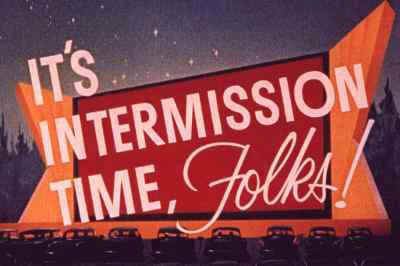Initial release 1987 | ||
 | ||
Similar Let's All Go to the Lobby, 2001: A Space Odyssey, 90 Minutes, The Hateful Eight, West Side Story | ||
Intermission trailer
An intermission (American, Canadian English) or interval (British English) is a recess between parts of a performance or production, such as for a theatrical play, opera, concert, or film screening. It should not be confused with an entr'acte (French: "between acts"), which, in the 18th century, was a sung, danced, spoken, or musical performance that occurs between any two acts, that is unrelated to the main performance, and that thus in the world of opera and musical theatre became an orchestral performance that spans an intermission and leads, without a break, into the next act.
Contents
- Intermission trailer
- Old movie theater intermission
- Plays
- William Shakespeare
- Kabuki
- Films
- Indian cinema
- References
Jean-François Marmontel and Denis Diderot both viewed the intermission as a period in which the action did not in fact stop, but continued off-stage. "The interval is a rest for the spectators; not for the action," wrote Marmontel in 1763. "The characters are deemed to continue acting during the interval from one act to another." However, intermissions are more than just dramatic pauses that are parts of the shape of a dramatic structure. They also exist for more mundane reasons, such as that it is hard for audience members to concentrate for more than two hours at a stretch, and actors and performers (for live action performances at any rate) need to rest. They afford opportunity for scene and costume changes. Performance venues take advantage of them to sell food and drink.
Psychologically, intermissions cause audiences to return to reality, and are a period during which they can engage critical faculties that they have suspended during the performance itself.
Old movie theater intermission
Plays
The term "Broadway Bladder" names "the alleged need of a Broadway audience to urinate every 75 minutes". Broadway Bladder, and other considerations (such as how much revenue a theatre would lose at its bar if there were no intermissions), govern the placement of intermissions within performances, and their existence in performances, such as plays, that were not written/created with intermissions in mind.
William Shakespeare
The plays of William Shakespeare were originally intended for theatre performance without intermissions. The placement of intermissions within those plays in modern performances is thus a matter for the play's director. Reviewer Peter Holland analysed the placement of intermissions in 1997:
Many modern productions of Shakespeare plays have thus eschewed the introduction of an intermission, choosing instead to perform them straight through, as originally intended.
Kabuki
The intermissions in Kabuki theatre can last up to an hour. Because this often results in people returning to their seats several minutes after the performance has resumed, playwrights generally take to writing "filler" scenes for the starts of acts, containing characters and dialogue that are not important to the overall story.
Films
Intermissions in early films had a practical purpose: they were needed to facilitate the changing of reels. When Les Amours de la reine Élisabeth (The Loves of Queen Elizabeth), starring Sarah Bernhardt, opened on July 12, 1912, in the Lyceum Theatre in New York City, the four reel film was shown in four acts, with an intermission between each reel change.
The technology improved, but as movies became progressively longer, the intermission fulfilled other needs. It gave the audience a breather, and provided the theatre management an opportunity to entice patrons to its profitable concession stand. A 1957 animated musical snipe suggested, before the main feature in theatres and during intermission at drive-ins, "let's all go to the lobby to get ourselves a treat". And during the 3D film golden era of the early 1950s, intermissions were a necessity because even though many theaters used two projectors that could skip intermission by shifting from one reel to the other, 3D films required the use of both projectors - one for each stereoscopic image - and so needed an intermission to change the reels on both projectors.
The built-in intermission has been phased out of Hollywood films, the victim of the demand to pack in more screenings, advances in projector technology which make reel switches either unnoticeable or non-existent (such as digital projection, where reels also no longer exist) and also because in multiplexes, the break gave patrons a better opportunity to sneak away to watch other pictures.
Other notable films with intermissions include:
Indian cinema
Despite the phasing out of intermissions in the West, they have remained prevalent in India, and especially with Bollywood films. There is a mass reluctance to abolish intermissions as they bring a large revenue to cinemas through customers buying snacks during these periods. Indian films are also typically longer compared to films from other parts of the world. In 2011, a Bollywood film, Dhobi Ghat, was released without an intermission and was cited as a first in Indian cinema. Forced intermissions are common during screenings of western films in India.
Bollywood films shown in cinemas in the United Kingdom also commonly include intermissions. Many Bollywood films released on DVD include the "intermission" card for cinematic screening.
